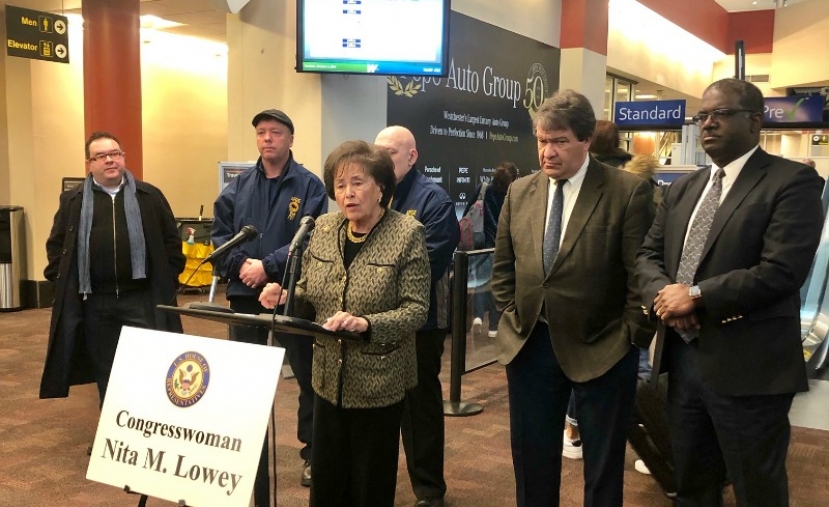 WASHINGTON: It’s not dead yet, but House appropriators took a stand against full funding for the Space Force which highlights the Trump Administration’s shaky ground as it tries to get the new service off the ground.
WASHINGTON: It’s not dead yet, but House appropriators took a stand against full funding for the Space Force which highlights the Trump Administration’s shaky ground as it tries to get the new service off the ground.
The House Appropriations Committee’s (HAC) version of the fiscal 2020 budget, released ahead of tomorrow’s mark-up, approves only $15 million for DoD to study the idea. No funding to create it. Not a dime.
The draft bill does not specify that no 2020 funds can be spent on the Space Force, one former DoD official who supports the White House proposal pointed out, so that leaves room for the Pentagon to reallocate funding. If it chooses to. But it will have to take that money from other pots.
“The $15 million could simply be the opening bid for how much we will spend in 2020 on establishing the Space Force. Authorizers are the key here, and I think they are going to endorse,” the former official said.
Todd Harrison, director of defense budget analysis at the Center for Strategic and International Security (CSIS), agreed, explaining that the HAC bill creates a new operations and maintenance account for the Space Force of which the $15 million is a first increment, even if it is only for a study. “They created an elementary budget structure,” he said, albeit one with very little money in it. “It’s budget dust,” he admitted, laughing.
The HAC, chaired by Democrat Nita Lowey, did not reject the concept, he stressed. “I think it’s been misreported,” he told me today. Still, Harrison, who supports the proposal, says his odds on the Space Force being fully approved this year are “slightly less than 50 percent.” Instead, he said, Congress may seek to hold off and lay more ground work for its eventual standup.
The HAC members are not the only skeptics in Congress. Democrats in the House Armed Service Committee (HASC) — that has the power to say yes or no to the creation of the Space Force but not the power to appropriate funding for it — are uncomfortable with the proposal. Chairman Adam Smith has been vocal about his intentions to re-work the administration’s draft legislation, which comes to mark-up in June. (The fact that the HAC moved ahead of the authorizing committee has reversed the legislative process and makes things a bit confused.)
The Republican-led Senate — especially the Senate Appropriations Committee that is led by Sen. Richard Shelby and includes uber Trump ally Senate Majority Leader Mitch McConnell — is more likely to bow to administration wishes. But Senate Armed Services Committee Chairman (SASC) James Inhofe has also said that he is not convinced the Pentagon’s approach is the right way to enhance the security of US military and intelligence space capabilities. The SASC marks up the 2020 NDAA this week.
Harrison said Inhofe’s position is most important in the legislative dance. The HASC will approve some type of new military entity for space though it may not be in line with the White House proposal.
Experts agree that the critical problem is the lack of detail within the Pentagon’s proposal about both the need for the Space Force, and the process to establish it. “DoD didn’t put enough details in it for Congress to be comfortable with it,” Harrison said. This is especially true for the creation of the Space Development Agency (SDA), overseen by Undersecretary for Research and Engineering Mike Griffin, to improve space systems acquisition (which is the one thing almost everyone agrees is sorely needed.)
The HAC bill does prevent any DoD spending by the SDA until after the Pentagon and the Air Force provide a detailed blueprint of how they will coordinate on space systems research, development and procurement and parcel out oversight of new programs. After all, the Air Force already has the Space and Missile Systems Center (SMC) which builds almost all space weapons. Likewise, the bill restricts the Air Force spending for Next Generation Overhead Persistent Infrared (Next-Gen OPIR) program, the new missile warning constellation, to no more than 50 percent of the $1.395 billion the HAC appropriated. That sum is a cut of almost $202 million to the Air Force’s $1.4 billion request.
The HAC bill states that the Committee is “is generally supportive” of the SDA concept, it is concerned that this effort may create a parallel space program that will overlap and duplicate existing programs and missions in the Air Force. Therefore, the Committee recommendation includes a legislative provision requiring the Space Development Agency and the Air Force to work together to define a unified and integrated space architecture and to clarify roles and responsibilities.”
Regarding Next-Gen OPIR, the HAC report said that the “Committee is concerned with the rapid budget growth and the Air Force strategy of relying on significant reprogramming requests to keep the program on schedule.” The Air Force 2020 request was almost double what it asked for in 2019.
New details emerge of Russia’s potential nuclear space weapon
“The United States has been aware of Russia’s pursuit of this sort of capability dating back years, but only recently have we been able to make a more precise assessment of their progress,” said Mallory Stewart, State Department assistant secretary for the Bureau of Arms Control, Deterrence, and Stability.


























